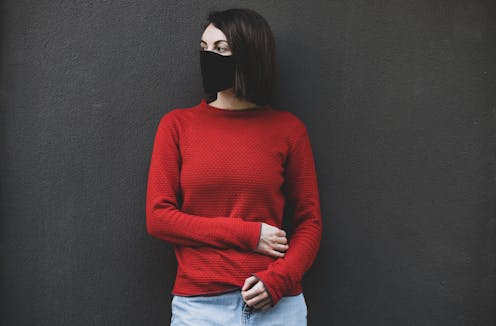New ad urges us to 'take on winter' by getting COVID and flu vaccines. But it misses some key things
- Written by Jessica Kaufman, Research Fellow, Vaccine Uptake Group, Murdoch Children's Research Institute

The federal government has released a new A$11 million ad campaign urging Australians to “take on winter” by getting COVID boosters and influenza vaccines, as well as promoting COVID vaccination for children.
The ads come at a crucial time. COVID booster vaccination rates have plateaued at 70% and only about 40% of children aged 5-11 have had two doses.
Yet COVID boosters – a third dose for most adults, or fourth dose for people over 65 years and in high risk groups – are critical. They increase protection against severe disease, which wanes within three months of the second COVID vaccine dose.
While most children experience relatively mild COVID symptoms, some children, including those who were previously healthy, can get very sick and need to be admitted to hospital. We don’t want kids to get COVID and vaccination can help to protect them.
On top of COVID, we’re also experiencing our biggest flu season since 2019, which has hit hard and early.
Older adults and children six months to five years are among the groups at the highest risk from flu. And since we’ve had no flu season during the pandemic, children under two years have never been exposed and have no immunity.
The new Take on Winter ad urges us to add COVID boosters and flu vaccination to our winter to-do lists.But while the government’s new ads get some things right, they miss the mark in other areas: they don’t connect on an emotional level by highlighting meaningful benefits of vaccination and they don’t address most people’s main concerns.
What makes a good campaign?
A well-designed campaign can raise awareness about vaccine availability and eligibility, shape social norms by emphasising shared values, and generate vaccine demand by highlighting the individual and collective benefits of vaccination.
Last year, we studied what people from the initial vaccine priority groups (health-care workers, people aged over 65 years and those with underlying health conditions) thought and felt about COVID vaccines, and what they wanted from communication campaigns and materials.
Based on what they told us, effective communication should:
- provide information about vaccine safety and effectiveness
- address people’s concerns about side effects
- highlight the broader benefits of vaccination, not just those related to personal health
- discuss the severity of COVID infection
- communicate about vaccine availability
- personalise information, to account for people’s underlying medical conditions and treatments
- use real, diverse spokespeople
- use clear and simple language, and build trust through transparency.
We also recommend using humour and emotion to generate engagement and enhance motivation to vaccinate, while avoiding fear-based messaging which can backfire or cause unintended harms.
What’s in the new campaign?
The Take on Winter ad meets some of our recommended criteria but falls short in other areas.
It makes clear the important message that it’s safe to get your COVID and flu shots at the same time.
It has a clear call to action – “book today” – and notes the vaccines are available at GPs and pharmacies.
However, its creators made the disappointing decision to recycle the unengaging, faceless arms of last year’s A$41 million Arm Yourself campaign, which fell flat and didn’t resonate with viewers.
Read more: Australia's new vaccination campaign is another wasted opportunity
In the child COVID vaccination ad, Kids will be kids, which was also released last week, the cast is diverse, but there’s no real link made between vaccination and the kids doing generic kid things.
What’s missing?
While a TV ad can’t do everything to address vaccine hesitancy, these ads have some notable gaps.
Neither of the government’s ads do much to address concerns about side effects. The most common reason parents cite for not vaccinating their children is concern about vaccine safety and side effects, even though children experience fewer side effects than adults. But the Kids will be Kids ad just uses a relatively simplistic motherhood statement about vaccine safety.
Adults are also concerned about side effects. Some people who had unpleasant, short-term side effects after dose two are reluctant to get a booster dose – though side effects after the booster are reported less frequently than after dose two. Communicating about how well vaccine safety is monitored in Australia and the low occurrence of common and expected side effects can reassure people.
The ads are also unlikely to generate an emotional response from viewers, which is an important part of motivating behaviour change. The Take on Winter ad fails to link COVID vaccine boosters or the flu shot with any meaningful personal benefits or motivators, such as being able to go to work, travel, socialise or see elderly grandparents. There is no emotional resonance.
And while we agree with the decision to avoid a fear-based message in Kids will be kids, one of the primary factors driving vaccine intention and uptake is perceived susceptibility to COVID. Many parents feel their kids aren’t at risk of serious disease, or they’ve already had COVID, so they don’t see the urgency or value in vaccinating them.
A more specific message about the importance of vaccination, even for people who have already had COVID, or personal stories from real parents of previously healthy kids who got very sick from COVID, would likely resonate more strongly.
Read more: Just the facts, or more detail? To battle vaccine hesitancy, the messaging has to be just right
We need to respect how discerning people are, especially as vaccine vaccine fatigue is high. For all the dollars spent, evidence from social and behavioural science should be reflected in the messaging to ensure the ads are as effective as they can be.
Authors: Jessica Kaufman, Research Fellow, Vaccine Uptake Group, Murdoch Children's Research Institute





